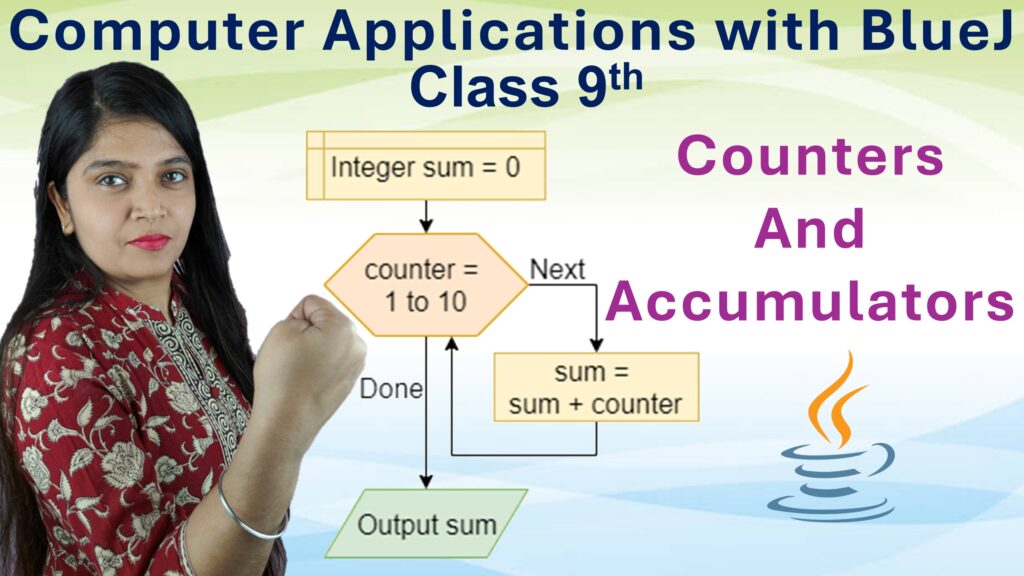Exercise: 1-B
Q1: Multiple Choice Type:
i. The sum of two rational numbers is 8, if one of them is \(2\frac{3}{4}\) , the other number is:
Solution:
Let the other number be \(x\)
Given:
\[ x + 2\frac{3}{4} = 8 \]
Convert mixed number to improper fraction:
\[ x + \frac{11}{4} = 8 \]
Now subtract \(\frac{11}{4}\) from both sides:
\[ x = 8 – \frac{11}{4} \]
\[ x = \frac{32}{4} – \frac{11}{4} \]
\[ x = \frac{21}{4} \]
Convert back to mixed number:
\[ \frac{21}{4} = 5\frac{1}{4} \]
Correct Answer: (c) \(5\frac{1}{4}\)
ii. For three rational numbers \(\frac{a}{b},\frac{c}{d}\ and\ \frac{e}{f}\), we have:
Solution:
We know the identity:
\[ a – (b – c) = a – b + c \]
So applying this property:
\[ \frac{a}{b}-\left(\frac{c}{d}-\frac{e}{f}\right) = \frac{a}{b} – \frac{c}{d} + \frac{e}{f} \]
Correct Answer: (a)
iii. The sum of two rational numbers is -6. If one of them is \(4\frac{1}{2}\) , other number is:
Solution:
Let the other number be \(x\)
We are given:
\[ x + 4\frac{1}{2} = -6 \]
Convert mixed number:
\[ x + \frac{9}{2} = -6 \]
Subtract \(\frac{9}{2}\) from both sides:
\[ x = -6 – \frac{9}{2} \]
\[ x = \frac{-12}{2} – \frac{9}{2} = \frac{-21}{2} \]
Convert to mixed number:
\[ \frac{-21}{2} = -10\frac{1}{2} \]
Correct Answer: (d) \(-10\frac{1}{2}\)
iv. The number subtracted from \(5\frac{2}{3}\) to get \(-1\frac{2}{3}\) is:
Solution:
Let the number be \(x\)
We are given:
\[ 5\frac{2}{3} – x = -1\frac{2}{3} \]
Convert mixed numbers:
\[ \frac{17}{3} – x = \frac{-5}{3} \]
Now solve:
\[ -x = \frac{-5}{3} – \frac{17}{3} = \frac{-22}{3} \]
Multiply both sides by -1:
\[ x = \frac{22}{3} = 7\frac{1}{3} \]
Correct Answer: (d) \(7\frac{1}{3}\)
v. The number added to \(5\frac{2}{3}\) to get \(-1\frac{2}{3}\) is:
Solution:
Let the number be \(x\)
We are given:
\[ 5\frac{2}{3} + x = -1\frac{2}{3} \]
Convert mixed numbers:
\[ \frac{17}{3} + x = \frac{-5}{3} \]
Solve for \(x\):
\[ x = \frac{-5}{3} – \frac{17}{3} = \frac{-22}{3} \]
Convert to mixed number:
\[ \frac{-22}{3} = -7\frac{1}{3} \]
Correct Answer: (b) \(-7\frac{1}{3}\)
Q2: Evaluate
i. \(\frac{2}{3}-\frac{4}{5}\)
Step 1: Find LCM of 3 and 5 = 15
Step 2: Convert to like denominators:
\[
\frac{2}{3} = \frac{10}{15},\quad \frac{4}{5} = \frac{12}{15}
\]
Step 3: Subtract:
\[
\frac{10}{15} – \frac{12}{15} = \frac{-2}{15}
\]
Answer: \(\frac{-2}{15}\)
ii. \(\frac{-4}{9}-\frac{2}{-3}\)
Note: \(\frac{2}{-3} = -\frac{2}{3}\)
\[
\frac{-4}{9} – \left(-\frac{2}{3}\right) = \frac{-4}{9} + \frac{2}{3}
\]
Step 1: LCM of 9 and 3 = 9
\[
\frac{-4}{9} + \frac{2}{3} = \frac{-4}{9} + \frac{6}{9} = \frac{2}{9}
\]
Answer: \(\frac{2}{9}\)
iii. \(-1-\frac{4}{9}\)
Convert \(-1\) to fractional form:
\[
-1 = \frac{-9}{9}
\]
\[
\frac{-9}{9} – \frac{4}{9} = \frac{-13}{9}
\]
Answer: \(\frac{-13}{9}\)
iv. \(\frac{-2}{7}-\frac{3}{14}\)
LCM of 7 and 14 = 14
\[
\frac{-2}{7} = \frac{-4}{14}
\]
\[
\frac{-4}{14} – \frac{3}{-14} = \frac{-4}{14} + \frac{3}{14} = \frac{-1}{14}
\]
Answer: \(\frac{-1}{14}\)
v. \(\frac{-5}{18}-\frac{-2}{9}\)
Note: \(\frac{-2}{9} = -\frac{4}{18}\)
\[
\frac{-5}{18} – (-\frac{4}{18}) = \frac{-5}{18} + \frac{4}{18} = \frac{-1}{18}
\]
Answer: \(\frac{-1}{18}\)
vi. \(\frac{5}{21}-\frac{-13}{42}\)
Note: Subtracting negative = adding:
\[
\frac{5}{21} + \frac{13}{42}
\]
LCM of 21 and 42 = 42
\[
\frac{5}{21} = \frac{10}{42}
\]
\[
\frac{10}{42} + \frac{13}{42} = \frac{23}{42}
\]
Answer: \(\frac{23}{42}\)
Q3: Subtract
i. \(\frac{5}{8}\ from\ \frac{-3}{8})\)
This means: \(\frac{-3}{8} – \frac{5}{8} = \frac{-8}{8} = -1\)
Answer: \(-1\)
ii. \(\frac{-8}{11}\ from\ \frac{4}{11}\)
\(\frac{4}{11} – \frac{-8}{11} = \frac{4}{11} + \frac{8}{11} = \frac{12}{11}\)
Answer: \(\frac{12}{11}\)
iii. \(\frac{4}{9}\ from\ \frac{-5}{9}\)
\(\frac{-5}{9} – \frac{4}{9} = \frac{-9}{9} = -1\)
Answer: \(-1\)
iv. \(\frac{1}{4}\ from\ \frac{-3}{8}\)
LCM of 4 and 8 = 8
\[
\frac{1}{4} = \frac{2}{8}, \quad \frac{-3}{8} – \frac{2}{8} = \frac{-5}{8}
\]
Answer: \(\frac{-5}{8}\)
v. \(\frac{-5}{8}\ from\ \frac{-13}{16}\)
Convert to like denominators: LCM = 16
\[
\frac{-5}{8} = \frac{-10}{16}
\]
\[
\frac{-13}{16} – \frac{-10}{16} = \frac{-13}{16} + \frac{10}{16} = \frac{-3}{16}
\]
Answer: \(\frac{-3}{16}\)
vi. \(\frac{-9}{22}\ from\ \frac{5}{33}\)
LCM of 22 and 33 = 66
\[
\frac{-9}{22} = \frac{-27}{66}, \quad \frac{5}{33} = \frac{10}{66}
\]
\[
\frac{10}{66} – \frac{-27}{66} = \frac{10}{66} + \frac{27}{66} = \frac{37}{66}
\]
Answer: \(\frac{37}{66}\)
Q4: The sum of two rational numbers is \(\frac{9}{20}\). If one of them is \(\frac{2}{5}\), find the other.
Solution:
Let the other number be \(x\).
We are given:
\[
x + \frac{2}{5} = \frac{9}{20}
\]
Subtract \(\frac{2}{5}\) from both sides:
\[
x = \frac{9}{20} – \frac{2}{5}
\]Convert \(\frac{2}{5}\) to have a denominator of 20:
\[
\frac{2}{5} = \frac{8}{20}
\]Now subtract:
\[
x = \frac{9}{20} – \frac{8}{20} = \frac{1}{20}
\]Answer: \(\frac{1}{20}\)
Q5: The sum of two rational numbers is \(\frac{-2}{3}\). If one of them is \(\frac{-8}{15}\), find the other.
Solution:
Let the other number be \(x\).
We are given:
\[
x + \left(\frac{-8}{15}\right) = \frac{-2}{3}
\]To isolate \(x\), add \(\frac{8}{15}\) to both sides:
\[
x = \frac{-2}{3} + \frac{8}{15}
\]Convert \(\frac{-2}{3}\) to denominator 15:
\[
\frac{-2}{3} = \frac{-10}{15}
\]Now add:
\[
x = \frac{-10}{15} + \frac{8}{15} = \frac{-2}{15}
\]Answer: \(\frac{-2}{15}\)
Q6: The sum of the two rational numbers is -6. If one of them is \(\frac{-8}{5}\) , find the other.
Solution:
Let the other number be \(x\).
We are given:
\[
x + \left(\frac{-8}{5}\right) = -6
\]
To isolate \(x\), add \(\frac{8}{5}\) to both sides:
\[
x = -6 + \frac{8}{5}
\]Convert \(-6\) to a fraction with denominator 5:
\[
-6 = \frac{-30}{5}
\]Now add:
\[
x = \frac{-30}{5} + \frac{8}{5} = \frac{-22}{5}
\]Convert the improper fraction to a mixed number:
\[
\frac{-22}{5} = -4\frac{2}{5}
\]Answer: \(-4\frac{2}{5}\)
Q7: Which rational number should be added to \(\frac{-7}{8}\) to get \(\frac{5}{9}\)?
Solution:
Let the required number be \(x\).
We are given:
\[
x + \left(\frac{-7}{8}\right) = \frac{5}{9}
\]To isolate \(x\), add \(\frac{7}{8}\) to both sides:
\[
x = \frac{5}{9} + \frac{7}{8}
\]Now find the LCM of 9 and 8:
LCM(9, 8) = 72
Convert both fractions to have denominator 72:
\[
\frac{5}{9} = \frac{40}{72}, \quad \frac{7}{8} = \frac{63}{72}
\]Add the two fractions:
\[
x = \frac{40}{72} + \frac{63}{72} = \frac{103}{72}
\]Convert the improper fraction to a mixed number:
\[
\frac{103}{72} = 1\frac{31}{72}
\]Answer: \(1\frac{31}{72}\)
Q8: Which rational number should be added to \(\frac{-5}{9}\) to get \(\frac{-2}{3}\)?
Solution:
Let the required number be \(x\).
We are given:
\[
x + \left(\frac{-5}{9}\right) = \frac{-2}{3}
\]To isolate \(x\), add \(\frac{5}{9}\) to both sides:
\[
x = \frac{-2}{3} + \frac{5}{9}
\]
Now find the LCM of 3 and 9:
LCM(3, 9) = 9
Convert both fractions to have denominator 9:
\[
\frac{-2}{3} = \frac{-6}{9}
\]Now add:
\[
x = \frac{-6}{9} + \frac{5}{9} = \frac{-1}{9}
\]Answer: \(\frac{-1}{9}\)
Q9: Which rational number should be subtracted from \(\frac{-5}{6}\) to get \(\frac{4}{9}\)?
Solution:
Let the required number be \(x\).
According to the question:
\[
\frac{-5}{6} – x = \frac{4}{9}
\]To find \(x\), subtract \(\frac{-5}{6}\) from both sides:
\[
-x = \frac{4}{9} – \left(\frac{-5}{6}\right)
\]Use the rule: subtracting a negative is like adding:
\[
-x = \frac{4}{9} + \frac{5}{6}
\]Find the LCM of 9 and 6:
LCM(9, 6) = 18
Convert both to have denominator 18:
\[
\frac{4}{9} = \frac{8}{18}, \quad \frac{5}{6} = \frac{15}{18}
\]Now add:
\[
-x = \frac{8}{18} + \frac{15}{18} = \frac{23}{18}
\]Multiply both sides by -1:
\[
x = -\frac{23}{18}
\]Answer: \(\frac{-23}{18}\)
Q10:
i. What should be subtracted from \(-2\) to get \(\frac{3}{8}\)?Solution:
Let the required number be \(x\).
According to the question:
\[
-2 – x = \frac{3}{8}
\]Now, isolate \(x\):
\[
-x = \frac{3}{8} + 2
\]Convert 2 into a fraction with denominator 8:
\[
2 = \frac{16}{8}
\Rightarrow -x = \frac{3}{8} + \frac{16}{8} = \frac{19}{8}
\]Multiply both sides by -1:
\[
x = -\frac{19}{8}
\]Answer: \(\frac{-19}{8}\)
ii. What should be added to -2 to get \(\frac{3}{8}\)?Solution:
Let the required number be \(x\).
According to the question:
\[
-2 + x = \frac{3}{8}
\]Now, isolate \(x\):
\[
x = \frac{3}{8} + 2
\]Convert 2 to a fraction with denominator 8:
\[
2 = \frac{16}{8}
\Rightarrow x = \frac{3}{8} + \frac{16}{8} = \frac{19}{8}
\]Answer: \(\frac{19}{8}\)
Q11: Evaluate:
i. \(\frac{3}{7}+\frac{-4}{9}-\frac{-11}{7}-\frac{7}{9}\)
Solution:
Group terms with same denominators:
\[
\left(\frac{3}{7} – \frac{-11}{7}\right) + \left(\frac{-4}{9} – \frac{7}{9}\right)
\]Simplify each group:
\[
= \left(\frac{3}{7} + \frac{11}{7}\right) + \left(\frac{-4 – 7}{9}\right)
= \left(\frac{14}{7}\right) + \left(\frac{-11}{9}\right)
\]Now simplify:
\[
= 2 – \frac{11}{9}
= \frac{18}{9} – \frac{11}{9}
= \frac{7}{9}
\]Answer: \(\frac{7}{9}\)
ii. \(\frac{2}{3}+\frac{-4}{5}-\frac{1}{3}-\frac{2}{5}\)
Solution:
Group terms with same denominators:
\[
\left(\frac{2}{3} – \frac{1}{3}\right) + \left(\frac{-4}{5} – \frac{2}{5}\right)
\]
Simplify:
\[
= \left(\frac{1}{3}\right) + \left(\frac{-6}{5}\right)
\]Find LCM of 3 and 5 = 15:
\[
\frac{1}{3} = \frac{5}{15}, \quad \frac{-6}{5} = \frac{-18}{15}
\]Now subtract:
\[
\frac{5}{15} – \frac{18}{15} = \frac{-13}{15}
\]Answer: \(\frac{-13}{15}\)
iii. \(\frac{4}{7}-\frac{-8}{9}-\frac{-13}{7}+\frac{17}{9}\)
Solution:
Group like denominators:
\[
\left(\frac{4}{7} + \frac{13}{7}\right) + \left(\frac{8}{9} + \frac{17}{9}\right)
\]Simplify:
\[
= \frac{17}{7} + \frac{25}{9}
\]Find LCM of 7 and 9 = 63:
\[
\frac{17}{7} = \frac{153}{63}, \quad \frac{25}{9} = \frac{175}{63}
\]Now add:
\[
\frac{153 + 175}{63} = \frac{328}{63}
\]Answer: \(\frac{328}{63}\)







Leave a Comment